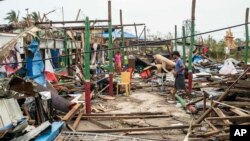While United Nations and international aid agencies are racing to provide lifesaving aid to survivors of Cyclone Mocha in Bangladesh and Myanmar, humanitarians are expressing frustration at bureaucratic and political restrictions imposed by Myanmar's military rulers.
Cyclone Mocha, the most powerful storm to hit the Bay of Bengal in the past 10 years, made three landfalls with brutal force on Sunday, uprooting trees, ripping off roofs and breaking down power lines as winds of 250 kph swept through the region.
The first area to be hit was Rakhine State, where some 600,000 Rohingya Muslims live, nearly 150,000 of them in camps for internally displaced people. Landfalls followed in Chin State and Northern Sagaing region.
"The access is challenged mostly in Northern Rakhine where the typhoon hit severely," said Rajeeve K.C., disaster risk management delegate for the International Federation of Red Cross and Red Crescent Societies (IFRC).
Speaking from Myanmar's capital, Yangon, he said "Chin and Northern Sagaing region are also heavy restricted areas in terms of access."
Unrest, violence
Civil unrest and armed violence have increased in both places since the military junta mounted a coup against the democratically elected government on February 1, 2021.
Myanmar did not comment on the issue of restrictions, but state media said Tuesday that junta chief Min Aung Hlaing had visited Rakhine's capital Sittwe to assess the damage.
Rajeev K.C. said 849 volunteers from the International Committee of the Red Cross have been at the forefront of efforts to curb the disaster in Myanmar. At the same time, he said, IFRC volunteers are "on standby to provide strategic, operational, financial, technical and other support."
However, he noted the "IFRC was not able to collect primary data from the field because of the existing limitations," noting that "access remained one of the key challenges" in providing lifesaving relief to the people in Myanmar.
5.4 million in storm's path
Ramanathan Balakrishnan, the U.N. resident and humanitarian coordinator in Myanmar, said 5.4 million people were expected to have been in the path of the cyclone, with some 3.9 million considered to be the most vulnerable.
"It is really a nightmare scenario for the cyclone to hit areas with such deep pre-existing needs," said Balakrishnan. "These are some of the poorest parts of the country. The people are still reeling from accumulative crises of COVID, conflict, political and economic upheaval. Now they are also in the frontline of the climate crisis."
Balakrishnan said that coping capacities were stretched to the limit and the needs for humanitarian support will be extremely high.
"To deliver, we will need access to the people, relaxation of travel authorization by the authorities, require an expedited custom clearance for commodities. Of course, we will also need a huge infusion of funds to respond to this massive need."
Balakrishnan noted that the U.N.'s $763 million humanitarian response plan was only 10% funded.
"It is worth remembering that 17.6 million people were already in humanitarian need in Myanmar even before this disaster," Balakrishnan said. "To put that in perspective, that is the same number of people in humanitarian need as it is in Ukraine."
Basics needed
Speaking from Yangon, Balakrishnan cited health, shelter, water, sanitation and hygiene support as early priorities.
The World Health Organization (WHO), which is delivering health care to people in Myanmar and Bangladesh, said the major impact of the cyclone has been in Myanmar.
Edwin Salvador, WHO South-East Asia regional emergency director, said unofficial reports indicate 14 health facilities across the country have been damaged.
He said "WHO staff will reach affected areas as soon as possible to identify the impact and what further support is needed.
"Currently, we have event-based surveillance planned for difficult-to-access areas, to gather information from as many sources as possible … and take timely action."
He warned that in flooded areas where safe drinking water and sanitation is lacking, people are at "risk of waterborne diseases, such as diarrhea, hepatitis, and those caused by mosquitoes such as dengue and malaria."
To move things along in the right direction, Balakrishnan said the U.N. has opened communication channels with all authorities in Myanmar and has asked for unrestricted access to affected communities.
"The one thing we do not want is politicization of the humanitarian aid," he said. "That is very important."









